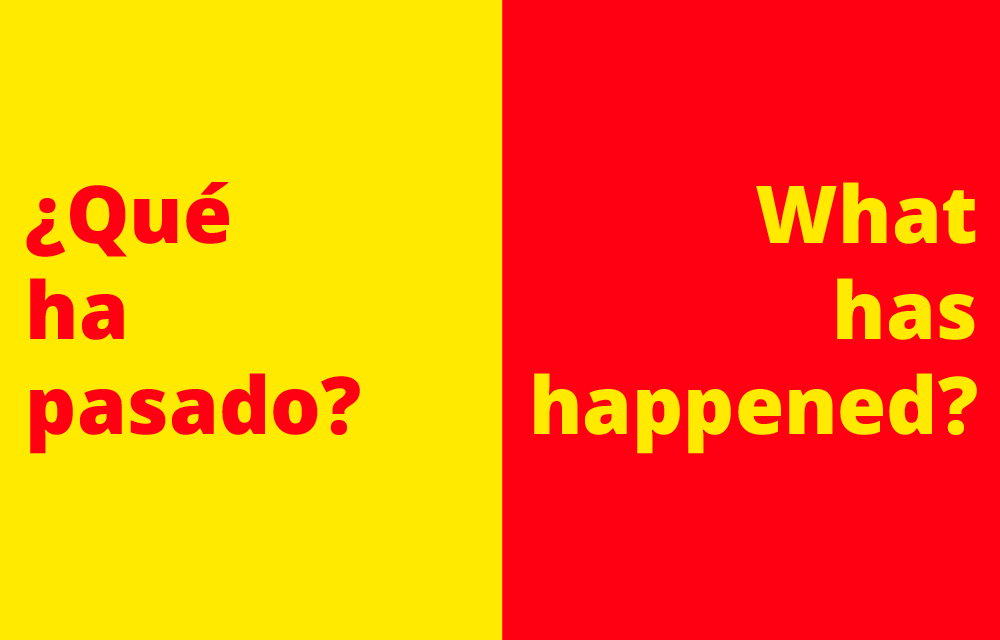In this topic we are going to learn more about how to use The Spanish Present Perfect (El Pretérito Perfecto).
In the previous lesson we learned how to use The Spanish Present Perfect with regular verbs. In this lesson we will focus on how to use it with irregular verbs.
The Spanish Present Perfect is used to talk about things that started in the past and which continue or repeat in the present. It’s also used to talk about things that have happened in the recent past.
You use the Spanish verb Haber (To Have) in the present tense with a past participle: Yo-He-Past Participle, Tú–Has-Past Participle, Él/Ella–Ha-Past Participle, Nosotros–Hemos-Past Participle, Vosotros–Habéis-Past Participle, Ellos/Ellas–Han-Past Participle.
Conjugating regular Spanish past participles it quite easy. Regular verbs ending in –ar change to -ado and regular verbs ending in –er and –ir change to –ido. With the irregular verbs there is unfortunately no pattern to follow when conjugating them into past participles and we have to simply remember the ending specific to each one.
Here are some irregular Spanish Past Particples used with The Spanish Present Perfect (El Pretérito Perfecto):
Abrir – Abierto: Opened
Cubrir – Cubierto: Covered
Decir – Dicho: Said
Descubrir – Descubierto: Discovered
Escribir – Escrito: Written
Freír – Frito: Fried
Hacer – Hecho: Done
Morir – Muerto: Died
Poner – Puesto: Put
Resolver – Resuelto: Resolved
Romper – Roto: Broken
Ver – Visto: Seen
Volver – Vuelto: Returned

Example conversation:
Ana: Hola Miguel. ¿Has visto lo que ha pasado? (Hi Miguel. Have you seen what has happened?)
Miguel: Hola Ana. ¿Te refieres a mi piano? (Hi Ana. Do you mean with my piano?)
Ana: Sí, lo siento mucho Miguel. (Yes, I am so sorry Miguel.)
Miguel: Lo he descubierto hace diez minutos cuando he vuelto del trabajo. ¿Que ha pasado? (I have discovered it ten minutes ago when I have returned from work. What has happened?)
Ana: Ha sido el niño. (It has been the boy.)
Miguel: ¡¿Pablo ha hecho eso?! (Pablo has done that?!)
Ana: Sí lo ha hecho. Pero, por favor, no te enfades demasiado con él. (Yes he has done it. But please don´t be too angry with him.)
Miguel: ¿Qué ha pasado? ¿Cómo ha roto la tapa del piano? (What has happened? How has he broken the top of the piano?)
Ana: Siéntate un momento Miguel. ¿Quieres una taza de té de menta? (Sit down for a moment Miguel. Would you like a cup of mint tea?)
Miguel: Por favor, cuéntame qué ha pasado Ana. ¡Cómo ha roto Pablo mi piano Steinway! (Please just tell me what has happened Ana. How has Pablo broken my Steinway Piano!)
Ana: Bueno, sus amigos Juan, Rodolfo y Alberto han venido de visita esta tarde para jugar con Pablo. Ahora han vuelto a casa. (Well, his friends Juan, Rodolfo, and Alberto have come for a visit this afternoon to play with Pablo. They have returned home now.)
Miguel: Sí, he visto sus huellas de barro y no queda zumo en el frigorífico. (Yes, I have seen their muddy footprints and there is no juice left in the fridge.)
Ana: Han jugado en tu habitación. Los he descubierto jugando con sus juguetes encima del piano. (They have played in your room. I have discovered them playing with their toys on top of the piano.)
Miguel: Pablo sabe que no debe tocar mi piano. (Pablo knows that he mustn’t touch my piano.)
Ana: Sí, lo sabe. Estaba intentando proteger tu piano. (Yes, he knows it. He was trying to protect your piano.)
Miguel: ¿En serio? (Seriously?)
Ana: Sí,. Creo que Rodolfo ha abierto la tapa del piano y ha puesto uno de sus juguetes en las cuerdas… Entonces se ha subido al piano para recuperar el juguete… Y Pablo ha intentado detenerlo… Pero ambos se han caído al piano. (Yes. I think Rodolfo has opened the top of the piano and put one of his toys onto the strings… He has then climbed into the piano to retrieve the toy… And Pablo has tried to stop him… But they have both fallen into the piano.)
Miguel: ¡Y han destrozado mi piano! ¡¿Donde está ese Rodolfo?! (And they have destroyed my piano! Where is that Rodolfo?!)
Read, watch, listen to, and speak as much Spanish as you can, as often as you can
We hope you found this lesson about the irregular verbs of The Spanish Present Perfect (El Pretérito Perfecto) useful! It takes time to remember any irregular verbs, so don’t be too hard on yourself if you find them tricky to use at this stage.
You can try to learn a few of these irregular verbs each day if you are very diligent, or you can relax and learn them little by little. After time you will become familiar with them for sure. But you do have to use them.
Read, watch, listen to, and speak as much Spanish as you can, as often as you can. After you have seen, heard, and used them in context various times, they will start to stick in your memory.





